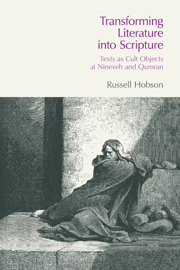Book contents
- Frontmatter
- Contents
- Acknowledgements
- Abbreviations
- 1 Authoritative Texts in the Hebrew and Cuneiform Traditions
- 2 Formulating a New Comparative Approach
- 3 Choosing the Right Texts
- 4 Study One: Enūma Anu Enlil Tablet 63
- 5 Study Two: Mul.Apin
- 6 Study Three: The Laws of Hammurabi
- 7 Study Four: Tablet XI of the Epic of Gilgamesh
- 8 Study Five: Mīs Pî
- 9 Study Six: Manuscripts of Pentateuchal Texts from Near the Dead Sea
- 10 Interpreting the Evidence
- Notes
- Bibliography
- Index of Ancient References
- Index of Authors
- Index of Subjects
9 - Study Six: Manuscripts of Pentateuchal Texts from Near the Dead Sea
- Frontmatter
- Contents
- Acknowledgements
- Abbreviations
- 1 Authoritative Texts in the Hebrew and Cuneiform Traditions
- 2 Formulating a New Comparative Approach
- 3 Choosing the Right Texts
- 4 Study One: Enūma Anu Enlil Tablet 63
- 5 Study Two: Mul.Apin
- 6 Study Three: The Laws of Hammurabi
- 7 Study Four: Tablet XI of the Epic of Gilgamesh
- 8 Study Five: Mīs Pî
- 9 Study Six: Manuscripts of Pentateuchal Texts from Near the Dead Sea
- 10 Interpreting the Evidence
- Notes
- Bibliography
- Index of Ancient References
- Index of Authors
- Index of Subjects
Summary
Approaching the Evidence of the Dead Sea Pentateuchal Texts
The question of how to treat the evidence from the manuscripts of Pentateuchal texts from among the Dead Sea Scrolls deserves special consideration. While it seems obvious that all of the scrolls from the area of the Dead Sea should be subjected to the same process of examination, questions of how to approach the evidence from different localities are complicated by problems with the interpretation of archaeological data, and by issues associated with dating the finds through palaeographical and radiocarbon analyses. One must proceed only after addressing some critical questions that relate to the understanding of the textual evidence. Are all of the scrolls that contain texts of the Pentateuch from Qumran to be assessed on the same basis, or are some scrolls to be given more weight than others in the analysis? Should the scrolls from Qumran be treated as a discrete unit from those recovered from other sites in the Judaean Desert? Should we treat the scrolls from Masada, ostensibly written in the first century ce, separately to those written in the second century ce from Murabba'at, Naḥal Ḥever, and Wadi Sdeir? Or, accepting that the scrolls from all of these locations can only be examined in their overall context, should we examine them collectively, without delineating between scrolls from the bce and ce periods?
- Type
- Chapter
- Information
- Transforming Literature into ScriptureTexts as Cult Objects at Ninevah and Qumran, pp. 100 - 131Publisher: Acumen PublishingPrint publication year: 2012



